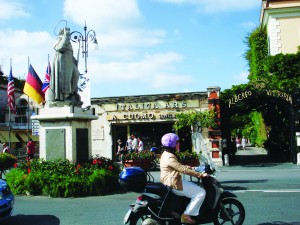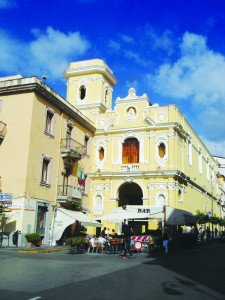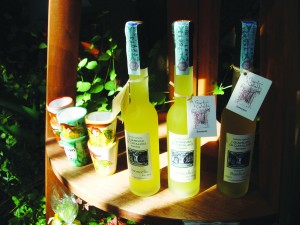Sunshine, sea, shopping and scooters – the things you can rely on in Sorrento throughout the year. Hannah Bellis discovers the sides of Sorrento it may be easy to miss…
 Whatever time of year you visit Sorrento, it always seems to be sunny, from the cheerful yellow façade of the church of Santa Maria del Carmine in bustling Piazza Tasso to the equally bustling sun-dappled shopping streets around via Cesareo. Perhaps this is what makes the place feel sunny – it is frequently bustling but never hurried. The beautiful sea vistas and pedestrianization of the centre that bans cars from 7pm brings things back to a holiday pace of life. The crowds can fill the roads with no cars to worry about. The trees are full of citrus fruit and the terraces awash with holidaymakers enjoying a drink or a coffee and watching the world go by.
Whatever time of year you visit Sorrento, it always seems to be sunny, from the cheerful yellow façade of the church of Santa Maria del Carmine in bustling Piazza Tasso to the equally bustling sun-dappled shopping streets around via Cesareo. Perhaps this is what makes the place feel sunny – it is frequently bustling but never hurried. The beautiful sea vistas and pedestrianization of the centre that bans cars from 7pm brings things back to a holiday pace of life. The crowds can fill the roads with no cars to worry about. The trees are full of citrus fruit and the terraces awash with holidaymakers enjoying a drink or a coffee and watching the world go by.
Any visitor will find this place charming – it exists as a holiday destination. On a map, it looks like two triangles joined by points at via Capo, so in reality it has six sides. It is certainly a city of different moods, all of them a treat.
I began as most visitors do at the Piazza Tasso of the centro storico, named after the 16th century poet Torquato Tasso, who was born in Sorrento. Most famous as the author the poem Jerusalem Delivered, he suffered from mental illness and died a few days before he was due to be crowned King of the Poets by the Pope. The square is a fitting monument celebrating the city’s most famous son – you’ll find a statue of him in its northeast corner. When I visited, a Dalí festival was on and the square full of surrealist sculpture alongside his statue, vibrant and thought-provoking amid the crowds, not unlike the poetry of the man himself. Here is the geographical heart of the city, tabled terraces, mopeds aplenty, and long walkways of clean grey swirled paving with decorative white shapes like tidemarks on a beach.
Venture towards the sea to find the small but calm green space of the Villa Comunale park, overlooking the Bay of Naples and Vesuvius. It’s another square of statues, leafy and green this time with street musicians and strollers replacing the tables, though you can enjoy a drink at the Bar Villa Comunale as you take in the view. Or else continue along the via Marin a Grande to enjoy the scenery as the sea drops away from you down towards the port.
a Grande to enjoy the scenery as the sea drops away from you down towards the port.
Marina Grande itself is another face of the city. Descending from the cliffs above you lose some of the otherwise ubiquitous sunshine as you are sheltered by the rocks around you. A little grotto of our Lady of Lourdes is carved into the rocks as you descend and statues and fountains grace the damp stone walls. In the marina you are enclosed by grey stone and coloured houses at your back, and the beautiful water of the cove in front. It is charmingly dilapidated. Fishing nets hang like bunting between the ornate street lights – this was the main port of Sorrento when it was still a small fishing village and fishermen still mend their nets alongside sleeping stray cats curled up in the boats. Because of the steep decent, and the peeling paint, this is a world away from the busy, sunny streets above, but still just as alluring. You can see it captured in celluloid alongside equally alluring Sophia Loren in the 1950s film, Scandal in Sorrento. Dining here is cheaper than in the main tourist area of town, plus you are in the right spot to get the freshest catch of the day!
Back in the centro storico, you can leave the open space and sea views of Piazza Tasso and the Corso Italia and enter the narrow cream streets around via Cesareo. The shopping and eating here is very appealing – lots of tourists shops interspersed with produce, clothing and jewellery stores, bars and restaurants. In some ways it is a touristy area, but look upwards – you will spot traditional Sorrento balconies, decorated in drying fruit and squash. There are still a good 15,000 inhabitants in Sorrento, and they often live right above the tourist hubbub.
Today the tiny fishing village of Sorrento has evolved into a prosperous town of 15 churches, which exists because of its many charms and its huge appeal to visitors. Most of the voices you hear in the street will be speaking English, or German, or even Chinese – the Italian language is not heard so often. But the welcome you receive and the safe friendly streets of the city more than make up for this. This is the authentic Sorrento experience today – the fishing village is long gone. But you can still find a little slice of it tucked away in the Marina Grande. It’s impossible not to be charmed by this small city with its many faces – and amazingly you can discover them all on foot within a couple of hours. But you’ll want to spend a lot longer here than that.
